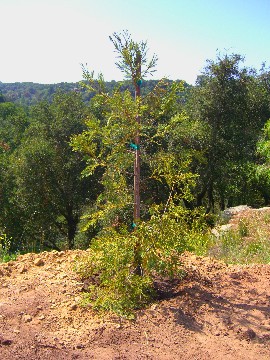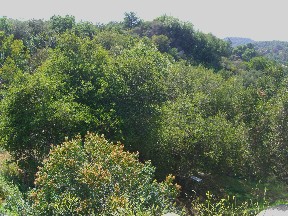Ranch & Country Magazine is happy to announce our new “Plant a Tree” program. Millions of magnificent trees have been lost due the severe drought throughout California and the west. Trees help reduce greenhouse gases and, in turn, mitigate the trend towards global warming.
 What’s so special about trees? Trees are very large plants, and plants can contribute to the reduction of greenhouse gases in the atmosphere through a process called “carbon sequestration.” Most American adults learned about “carbon sequestration” in elementary school, but it wasn’t called “carbon sequestration.” Instead, we were taught the simple fact that humans breathe in oxygen and exhale carbon dioxide, while plants ”breathe in” carbon dioxide and give off oxygen. As carefree school children, we were not aware that carbon dioxide is the most predominant of the greenhouse gases irrefutably found to be the primary contributing factor to a man-made trend on planet earth called “global warming.” What’s so special about trees? Trees are very large plants, and plants can contribute to the reduction of greenhouse gases in the atmosphere through a process called “carbon sequestration.” Most American adults learned about “carbon sequestration” in elementary school, but it wasn’t called “carbon sequestration.” Instead, we were taught the simple fact that humans breathe in oxygen and exhale carbon dioxide, while plants ”breathe in” carbon dioxide and give off oxygen. As carefree school children, we were not aware that carbon dioxide is the most predominant of the greenhouse gases irrefutably found to be the primary contributing factor to a man-made trend on planet earth called “global warming.”
Carbon dioxide enters the atmosphere through the burning of fossil fuels (oil, natural gas, and coal), and wood. On the other hand, carbon dioxide is removed from the atmosphere when it is absorbed by plants through carbon sequestration. Carbon sequestration is the process through which carbon dioxide from the atmosphere is absorbed by trees, plants and crops and then stored as carbon in tree trunks, branches, foliage and roots, and in the soil itself.
The larger the plant, the greater the capacity for sequestering. Large trees have the greatest capacity to sequester carbon and in turn to reduce carbon dioxide in the atmosphere. A tree will only sequester carbon if it’s a growing tree; fully mature trees do not contribute to the process of reducing carbon dioxide in the atmosphere. Also, when a tree is cut, carbon that has been sequestered in the tree is released back into the atmosphere as carbon dioxide. Therefore in order to have a significant impact on the amount of carbon dioxide in the atmosphere, new trees must be planted globally on a continuing basis and programs for world wide reforestation must be adopted.
A calculation of a person’s annual amount of carbon dioxide production through regular lifestyle practices is popularly referred to as one’s “carbon footprint.” A person who utilizes methods to successfully counter-balance his or her carbon footprint is said to be “carbon neutral.” One statistic show that if an average American were to use tree planting as the sole effort to become “carbon neutral,” he or she would have to plant 27 trees a year. This may seem like a lot of trees for a backyard or even a back forty, but there is a great deal of evidence to indicate that a tree planting is most effective for all of us if it is focused on the tropical forests.
Tropical rain forests, such as those located in Central and South America play a most significant role in regulating the intense impact of the sun’s heat on the entire planet. Some studies show that the humid conditions of the tropics increase carbon sequestration, and the year round warmth and moisture also fosters sequestration, resulting in a bigger payoff for tree planting.
 Each year millions of acres of tropical forests are destroyed. Most of the destruction is done to clear land for agriculture. A percentage of the destruction is for the timber. And another percentage is due to forest fires. When trees are cut, the sequestered carbon dioxide is released back into the atmosphere. Reforestation in tropical areas helps to counter-balance these extreme activities. Each year millions of acres of tropical forests are destroyed. Most of the destruction is done to clear land for agriculture. A percentage of the destruction is for the timber. And another percentage is due to forest fires. When trees are cut, the sequestered carbon dioxide is released back into the atmosphere. Reforestation in tropical areas helps to counter-balance these extreme activities.
In addition to tree planting, various other activities can assist in carbon sequestering. There are various land use practices that help foster the absorption of carbon dioxide from the atmosphere as a by-product of cropland management. Some of these practices include tillage practices, riparian buffers, grazing land management practices, and biofuel substitution. More information can be found at http://epa.gov/sequestration/
We have also recently learned about an extremely fast growing plant called “kenaf” that can be used in lieu of wood to produce paper. The kenaf plant is native to Africa but grows well in many parts of the United States. The following statistic is quoted from Vision Paper, a small innovative company that works with U.S. farmers to grow kenaf, manufactures paper and then sells it to businesses: “Kenaf grows quickly, rising to heights of 12-14 feet in as little as 4 to 5 months. U.S Department of Agriculture studies show the kenaf yields of 6 to 10 tons of dry fiber per acre per year are generally 3 to 5 times greater than the yield for Southern pine trees, which can take from 7 to 50 years to reach harvestable size.” Also of interest is that fact in spite of its aggressive growth capability, kenaf seeds require very specific conditions to germinate. Therefore there is very little danger that the plant would proliferate like a weed. Ranch & Country Magazine is in the process of further investigating the benefits of using kenaf paper for commercial printing, and the value of kenaf as an agricultural endeavor.
|